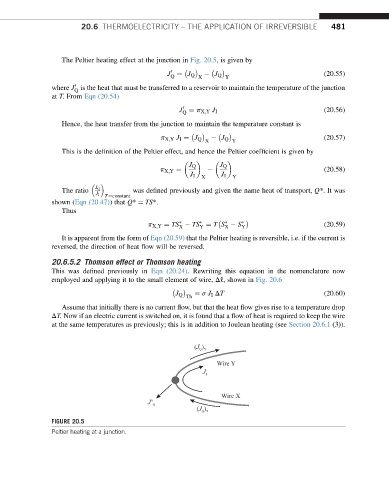Page 489 - Advanced thermodynamics for engineers
P. 489
20.6 THERMOELECTRICITY – THE APPLICATION OF IRREVERSIBLE 481
The Peltier heating effect at the junction in Fig. 20.5, is given by
0 (20.55)
J ¼ J Q X J Q Y
Q
where J is the heat that must be transferred to a reservoir to maintain the temperature of the junction
0
Q
at T. From Eqn (20.54)
0
J ¼ p X;Y J I (20.56)
Q
Hence, the heat transfer from the junction to maintain the temperature constant is
p X;Y J I ¼ J Q J Q (20.57)
X Y
This is the definition of the Peltier effect, and hence the Peltier coefficient is given by
J Q J Q
p X;Y ¼ (20.58)
J I X J I Y
The ratio J Q was defined previously and given the name heat of transport, Q*. It was
J I
T¼constant
shown (Eqn (20.47)) that Q* ¼ TS*.
Thus
p X;Y ¼ TS TS ¼ T S S Y (20.59)
X
X
Y
It is apparent from the form of Eqn (20.59) that the Peltier heating is reversible, i.e. if the current is
reversed, the direction of heat flow will be reversed.
20.6.5.2 Thomson effect or Thomson heating
This was defined previously in Eqn (20.24). Rewriting this equation in the nomenclature now
employed and applying it to the small element of wire, D[, shown in Fig. 20.6
J Q ¼ s J I DT (20.60)
Th
Assume that initially there is no current flow, but that the heat flow gives rise to a temperature drop
DT. Now if an electric current is switched on, it is found that a flow of heat is required to keep the wire
at the same temperatures as previously; this is in addition to Joulean heating (see Section 20.6.1 (3)).
(J )
QY
Wire Y
J I
Wire X
J' Q
(J )
QX
FIGURE 20.5
Peltier heating at a junction.

